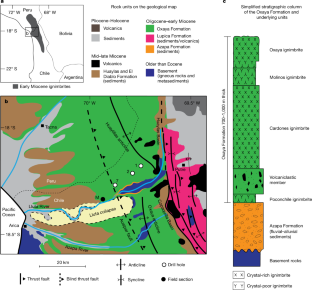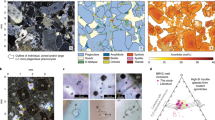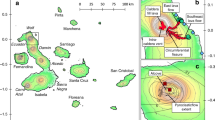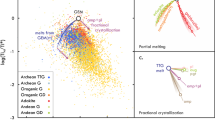Abstract
Generation of silicic magmas leads to emplacement of granite plutons, huge explosive volcanic eruptions and physical and chemical zoning of continental and arc crust1,2,3,4,5,6,7. Whereas timescales for silicic magma generation in the deep and middle crust are prolonged8, magma transfer into the upper crust followed by eruption is episodic and can be rapid9,10,11,12. Ages of inherited zircons and sanidines from four Miocene ignimbrites in the Central Andes indicate a gap of 4.6 Myr between initiation of pluton emplacement and onset of super-eruptions, with a 1-Myr cyclicity. We show that inherited zircons and sanidine crystals were stored at temperatures <470 °C in these plutons before incorporation in ignimbrite magmas. Our observations can be explained by silicic melt segregation in a middle-crustal hot zone with episodic melt ascent from an unstable layer at the top of the zone with a timescale governed by the rheology of the upper crust. After thermal incubation of growing plutons, large upper-crustal magma chambers can form in a few thousand years or less by dike transport from the hot-zone melt layer. Instability and disruption of earlier plutonic rock occurred in a few decades or less just before or during super-eruptions.
This is a preview of subscription content, access via your institution
Access options
Access Nature and 54 other Nature Portfolio journals
Get Nature+, our best-value online-access subscription
$29.99 / 30 days
cancel any time
Subscribe to this journal
Receive 51 print issues and online access
$199.00 per year
only $3.90 per issue
Buy this article
- Purchase on Springer Link
- Instant access to full article PDF
Prices may be subject to local taxes which are calculated during checkout




Similar content being viewed by others
Data availability
All data supporting the findings of this study are available within the paper and its Supplementary Information files. All isotopic and related geochemical data were placed in EarthChem: https://earthchem.org; https://doi.org/10.26022/IEDA/112268.
Code availability
Spreadsheets for carrying out the argon diffusion calculations can be found at: https://github.com/Thermochronology-At-Purdue/Oxaya2021.
References
Lipman, P. W. Incremental assembly and prolonged consolidation of Cordilleran magma chambers: evidence from the Southern Rocky Mountain volcanic field. Geosphere 3, 42–70 (2007).
Glazner, A. F., Bartley, J. M., Coleman, D. S., Gray, W. & Taylor, R. Z. Are plutons assembled over millions of years by amalgamation from small magma chambers? GSA Today 14, 4–12 (2004).
Bachmann, O., Miller, C. & De Silva, S. The volcanic–plutonic connection as a stage for understanding crustal magmatism. J. Volcanol. Geotherm. Res. 167, 1–23 (2007).
Frazer, R. E., Coleman, D. S. & Mills, R. D. Zircon U‐Pb geochronology of the Mount Givens Granodiorite: implications for the genesis of large volumes of eruptible magma. J. Geophys. Res. Solid Earth 119, 2907–2924 (2014).
Lipman, P. W. & Bachmann, O. Ignimbrites to batholiths: integrating perspectives from geological, geophysical, and geochronological data. Geosphere 11, 705–743 (2015).
Charlier, B. L. A. et al. Magma generation at a large, hyperactive silicic volcano (Taupo, New Zealand) revealed by U–Th and U–Pb systematics in zircons. J. Petrol. 46, 3–32 (2005).
de Silva, S. L. & Gosnold, W. D. Episodic construction of batholiths: insights from the spatiotemporal development of an ignimbrite flare-up. J. Volcanol. Geotherm. Res. 167, 320–335 (2007).
Sparks, R. S. J. et al. Formation and dynamics of magma reservoirs. Philos. Trans. R. Soc. A 377, 20180019 (2019).
Druitt, T. H., Costa, F., Deloule, E., Dungan, M. & Scaillet, B. Decadal to monthly timescales of magma transfer and reservoir growth at a caldera volcano. Nature 482, 77–80 (2012).
Shamloo, H. I. & Till, C. B. Decadal transition from quiescence to supereruption: petrologic investigation of the Lava Creek Tuff, Yellowstone Caldera, WY. Contrib. Mineral. Petrol. 174, 32 (2019).
Pamukçu, A. S., Wright, K. A., Gualda, G. A. R. & Gravley, D. Magma residence and eruption at the Taupo Volcanic Center (Taupo Volcanic Zone, New Zealand): insights from rhyolite‑MELTS geobarometry, diffusion chronometry, and crystal textures. Contrib. Mineral. Petrol. 175, 48 (2020).
Rubin, A. E. et al. Rapid cooling and cold storage in a silicic magma reservoir recorded in individual crystals. Science 356, 1154–1156 (2017).
Annen, C., Scaillet, B. & Sparks, R. S. J. Thermal constraints on the emplacement rate of a large intrusive complex: the Manaslu Leucogranite, Nepal Himalaya. J. Petrol. 47, 71–95 (2006).
Annen, C. From plutons to magma chambers: thermal constraints on the accumulation of eruptible silicic magma in the upper crust. Earth Planet. Sci. Lett. 284, 409–416 (2009).
Annen, C., Blundy, J. D., Leuthold, J. & Sparks, R. S. J. Construction and evolution of igneous bodies: towards an integrated perspective of crustal magmatism. Lithos 230, 206–221 (2015).
Gregg, P. M., de Silva, S. L., Grosfils, E. B. & Parmigiani, J. P. Catastrophic caldera-forming eruptions: thermomechanics and implications for eruption triggering and maximum caldera dimensions on Earth. J. Volcanol. Geotherm. Res. 241–242, 1–12 (2012).
Paterson, S., Okaya, D., Memeti, V., Economos, R. & Miller, R. B. Magma addition and flux calculations of incrementally constructed magma chambers in continental margin arcs: combined field, geochronologic, and thermal modeling studies. Geosphere 7, 1439–1468 (2011).
Annen, C., Blundy, J. D. & Sparks, R. S. J. The genesis of intermediate and silicic magmas in deep crustal hot zones. J. Petrol. 47, 505–539 (2006).
Solano, J. M. S., Jackson, M. D., Sparks, R. S. J., Blundy, J. D. & Annen, C. Segregation in deep crustal hot zones: a mechanism for chemical differentiation, crustal assimilation and the formation of evolved magmas. J. Petrol. 53, 1999–2026 (2012).
Cashman, K. V., Sparks, R. S. J. & Blundy, J. Vertically extensive and unstable magmatic systems: a unified view of igneous processes. Science 355, eaag3055 (2017).
Jackson, M., Blundy, J. & Sparks, R. S. J. Chemical differentiation, cold storage and remobilization of magma in the Earth’s crust. Nature 564, 405–409 (2018).
Seropian, G., Rust, A. & Sparks, R. S. J. The gravitational stability of lenses in magma mushes: confined Rayleigh-Taylor instabilities. J. Geophys. Res. 123, 3593–3607 (2017).
Walker, B. A., Grunder, A. L. & Wooden, J. L. Organization and thermal maturation of long-lived arc systems: evidence from zircons at the Aucanquilcha volcanic cluster, northern Chile. Geology 38, 1007–1010 (2010).
Cashman, K. V. & Giordano, G. Calderas and magma reservoirs. J. Volcanol. Geotherm. Res. 288, 28–45 (2014).
Cooper, K. M. & Kent, A. J. R. Rapid remobilization of magmatic crystals kept in cold storage. Nature 506, 480–483 (2014).
Andersen, N. L., Jicha, B. R., Singer, B. S. & Hildreth, W. Incremental heating of Bishop Tuff sanidine reveals preeruptive radiogenic Ar and rapid remobilization from cold storage. Proc. Natl Acad. Sci. 114, 12407–12412 (2017).
van Zalinge, M. E., Sparks, R. S. J., Cooper, F. J. & Condon, D. Early Miocene large-volume ignimbrites of the Oxaya Formation, Central Andes. J. Geol. Soc. 173, 716–733 (2016).
García, M., Gardeweg, M., Clavero, J. & Hérail, G. Arica map: Tarapacá region, scale 1:250,000. In: Carta Geológica de Chile, Serie Geología Básica, 84, Servicio Nacional de Geología y Minería, Santiago (2004).
Keller, C. B. Chron.jl: a Bayesian framework for integrated eruption age and age-depth modelling. https://doi.org/10.17605/osf.io/TQX3F (2018).
van Zalinge, M. E., Sparks, R. S. J. & Blundy, J. D. Petrogenesis of the large-volume Cardones ignimbrite, Chile; development and destabilization of a complex magma–mush system. J. Petrol. 58, 1975–2006 (2018).
Freymuth, H., Brandmeier, M. & Wörner, G. The origin and crust/mantle mass balance of Central Andean ignimbrite magmatism constrained by oxygen and strontium isotopes and erupted volumes. Contrib. Mineral. Petrol. 169, 58 (2015).
Lissenberg, C. J., Rioux, M., Shimizu, N., Bowring, S. A. & Mével, C. Zircon dating of oceanic crustal accretion. Science 323, 1048–1050 (2009).
Wotzlaw, J.-F. et al. Tracking the evolution of large-volume silicic magma reservoirs from assembly to supereruption. Geology 41, 867–870 (2013).
Samperton, K. M., Bell, E. A., Barboni, M., Keller, C. B. & Schoene, B. Zircon age-temperature-compositional spectra in plutonic rocks. Geology 45, 983–986 (2017).
Ellis, B. S. et al. Split-grain 40Ar/39Ar dating: integrating temporal and geochemical data from crystal cargoes. Chem. Geol. 457, 15–23 (2017).
Pinto, L., Hérail, G., Fontan, F. & Parseval, P. Neogene erosion and uplift of the western edge of the Andean Plateau as determined by detrital heavy mineral analysis. Sediment. Geol. 195, 217–237 (2007).
Wotzlaw, J. F., Decou, A., von Eynatten, H., Worner, G. & Frei, D. Jurassic to Palaeogene tectono-magmatic evolution of northern Chile and adjacent Bolivia from detrital zircon U-Pb geochronology and heavy mineral provenance. Terra Nova 23, 399–406 (2011).
Hora, J. M. et al. Volcanic biotite-sanidine 40Ar/39Ar age discordances reflect Ar partitioning and pre-eruption closure in biotite. Geology 38, 923–926 (2010).
Platzman, E. S., Sparks, R. S. J. & Cooper, F. J. Fabrics, facies, and flow through a large-volume ignimbrite: Pampa De Oxaya, Chile. Bull. Volcanol. 82, 8 (2020).
Schöpa, A. & Annen, C. The effects of magma flux variations on the formation and lifetime of large silicic magma chambers. J. Geophys. Res. Solid Earth 118, 926–942 (2013).
Schöpa, A., Annen, C., Dilles, J. H., Sparks, R. S. J. & Blundy, J. D. Magma emplacement rates and porphyry copper deposits: thermal modeling of the Yerington batholith, Nevada. Econ. Geol. 112, 1653–1672 (2018).
Burgmann, R. & Dresen, G. Rheology of the lower crust and upper mantle: evidence from rock mechanics, geodesy, and field observations. Annu. Rev. Earth Planet. Sci. 36, 531–567 (2008).
Petford, N., Cruden, A. R., McCaffrey, K. J. W. & Vigneresse, J. L. Granite magma formation, transport and emplacement in the Earth’s crust. Nature 408, 669–673 (2000).
Burov, E., Jaupart, C. & Guillou-Frottier, L. Ascent and emplacement of buoyant magma bodies in brittle-ductile upper crust. J. Geophys. Res. Solid Earth 108, 2177 (2003).
Suckale, J., Qin, Z., Picchi, D., Keller, T. & Battiato, I. Bistability of buoyancy-driven exchange flows in vertical tubes. J. Fluid Mech. 850, 525–550 (2018).
Jackson, M. D., Cheadle, M. J. & Atherton, M. P. Quantitative modeling of granitic melt generation and segregation in the continental crust. J. Geophys. Res. 108, 2332–2353 (2003).
Huppert, H. E. & Sparks, R. S. J. The generation of granite by intrusion of basalt into the continental crust. J. Petrol. 29, 599–624 (1988).
Bachmann, O. & Bergantz, G. W. Gas percolation in upper crustal silicic crystal mushes as a mechanism for upward heat advection and rejuvenation of near-solidus magma bodies. J. Volcanol. Geotherm. Res. 149, 85–102 (2006).
Huber, C., Bachmann, O. & Manga, M. Two competing effects of volatiles on heat transfer in crystal-rich magmas: thermal insulation vs defrosting. J. Petrol. 51, 847–867 (2010).
Mason, B., Pyle, D. & Oppenheimer, C. The size and frequency of the largest explosive eruptions on Earth. Bull. Volcanol. 66, 735–748 (2004).
Mark, D. F. et al. A high-precision 40Ar/39Ar age for the Young Toba Tuff and dating of ultra-distal tephra: forcing of Quaternary climate and implications for hominid occupation of India. Quat. Geochronol. 21, 90–103 (2014).
Renne, P. R., Cassata, W. S. & Morgan, L. E. The isotopic composition of atmospheric argon and 40Ar/39Ar geochronology: time for a change? Quat. Geochronol. 4, 288–298 (2009).
Lee, J. Y. et al. A redetermination of the isotopic abundances of atmospheric Ar. Geochim. Cosmochim. Acta 70, 4507–4512 (2006).
Mark, D. F., Stuart, F. M. & de Podesta, M. New high-precision measurements of the isotopic composition of atmospheric argon. Geochim. Cosmochim. Acta 75, 7494–7501 (2011).
Stoenner, R. W., Schaeffer, O. A. & Katcoff, S. Half-lives of argon-37, argon-39, and argon-42. Science 148, 1325–1328 (1965).
Renne, P. R. & Norman, E. B. Determination of the half-life of 37Ar by mass spectrometry. Phys. Rev. C 63, 047302 (2001).
Renne, P. R., Sharp, Z. D. & Heizler, M. T. Cl-derived argon isotope production in the CLICIT facility of OSTR reactor and the effects of the Cl-correction in 40Ar/39Ar geochronology. Chem. Geol. 255, 463–466 (2008).
Renne, P. R. Some footnotes to the optimization-based calibration of the 40Ar/39Ar system. Geol. Soc. Lond. Spec. Publ. 378, 21–31 (2014).
Renne, P. R., Mundil, R., Balco, G., Min, K. & Ludwig, K. R. Joint determination of 40K decay constants and 40Ar∗/40K for the Fish Canyon sanidine standard, and improved accuracy for 40Ar/39Ar geochronology. Geochim. Cosmochim. Acta 74, 5349–5367 (2010).
Renne, P. R., Mundil, R., Balco, G., Min, K. & Ludwig, K. R. Response to the comment by W. H. Schwarz et al. on “Joint determination of 40K decay constants and 40Ar∗/40K for the Fish Canyon sanidine standard, and improved accuracy for 40Ar/39Ar geochronology”. Geochim. Cosmochim. Acta 75, 5097–5100 (2011).
Kuiper, K. F. et al. Synchronizing rock clocks of Earth history. Science 320, 500–504 (2008).
Mark, D. F. et al. High-precision 40Ar/39Ar dating of Pleistocene tuffs and temporal anchoring of the Matuyama-Brunhes Boundary. Quat. Geochronol. 39, 1–23 (2017).
Ellis, B. S. et al. Split-grain 40Ar/39Ar dating: integrating temporal and geochemical data from crystal cargoes. Chem. Geol. 457, 15–23 (2017).
Jaffey, A. H., Flynn, K. F., Glendenin, L. E., Bentley, W. C. & Essling, A. M. Precision measurement of half-lives and specific activities of 235U and 238U. Phys. Rev. C 4, 1889 (1971).
Condon, D. J., Schoene, B., McLean, N. M., Bowring, S. A. & Parrish, R. R. Metrology and traceability of U–Pb isotope dilution geochronology (EARTHTIME Tracer Calibration Part I). Geochim. Cosmochim. Acta 164, 464–480 (2015).
McLean, N. M., Condon, D. J., Schoene, B. & Bowring, S. A. Evaluating uncertainties in the calibration of isotopic reference materials and multi-element isotopic tracers (EARTHTIME Tracer Calibration Part II). Geochim. Cosmochim. Acta 164, 481–502 (2015).
Wolf, R. A., Farley, K. A. & Kass, D. M. Modeling of the temperature sensitivity of the apatite (U–Th)/He thermochronometer. Chem. Geol. 148, 105–114 (1998).
McDougall, I., & Harrison, T. M. Geochronology and Thermochronology by the 40Ar/39Ar Method (Oxford Univ. Press, 1999).
Cassata, W. S. & Renne, P. R. Systematic variations of argon diffusion in feldspars and implications for thermochronometry. Geochim. Cosmochim. Acta 112, 251–287 (2013).
Acknowledgements
This project was financed by BHP supporting the PhD of M.E.v.Z. BHP has given permission to publish. K. Cooper and an anonymous reviewer are thanked for their supportive and careful reviews. Zircon and sanidine analyses were supported by Natural Environment Research Council (NERC) Isotope Geosciences Facilities Steering Committee grant IP-1466-1114 and Royal Society Research Grant RG140683 to F.J.C. D. Condon is thanked for his help with the analyses of inherited zircons. NERC are thanked for continued funding of the National Environmental Isotope Facility. R.S.J.S. acknowledges support of a Leverhulme Trust Emeritus Fellowship. There are no financial or non-financial competing interests.
Author information
Authors and Affiliations
Contributions
M.E.v.Z. carried out fieldwork, collected the samples and prepared them for geochronological analyses. D.F.M. conducted the 40Ar–39Ar analyses at the East Kilbride laboratories. C.B.K. and D.F.M. applied a Bayesian model to interpret the geochronological data. D.F.M. and R.S.J.S. integrated and interpreted the geochronology and developed the scientific narrative. M.M.T. contributed argon diffusion modelling to estimate storage temperatures and magma residence times for sanidine crystals. A.R. analysed Rayleigh–Taylor experiment data for the diapir detachment timescale. A.R. and R.S.J.S. developed the exchange flow models for magma transport. R.S.J.S. and D.F.M. led drafting the article and all authors contributed to the writing. F.J.C. and R.S.J.S. supervised PhD student M.E.v.Z. R.S.J.S. is the corresponding author. There are no financial or non-financial competing interests.
Corresponding author
Ethics declarations
Competing interests
The authors declare no competing interests.
Peer review
Peer review information
Nature thanks Kari Cooper and the other, anonymous, reviewer for their contribution to the peer review of this work. Peer reviewer reports are available.
Additional information
Publisher’s note Springer Nature remains neutral with regard to jurisdictional claims in published maps and institutional affiliations.
Extended data figures and tables
Extended Data Fig. 1 Repose interval durations.
The posterior distributions for the durations of the repose intervals of each sequential pair of eruptions (Poconchile to Cardones, Cardones to Molinos, and Molinos to Oxaya), as illustrated for each pair by a normalized histogram of the stationary distribution of a Markov chain Monte Carlo model that integrates the constraints provided by (1) the posterior eruption age distributions for each ignimbrite derived from the Bayesian eruption age models, as well as (2) the relative age constraints provided by the stratigraphic superposition of the ignimbrite deposits. Although the absolute time uncertainties of the absolute eruption ages shown in Fig. 2 are substantially increased by systematic (tracer/standard and decay constant) uncertainties, such systematic uncertainties effectively cancel when calculating the relative durations shown here.
Extended Data Fig. 2 The form of the relative closure distribution, scaled from time of first closure (1.0) to time of eruption (0.0).
The empirical (‘bootstrapped’) estimate of the form of this closure distribution (thick blue line) decreases as a function of time before eruption, following a trend closely resembling that of a similarly scaled exponential distribution (thick black line). This bootstrapped closure distribution is calculated as the kernel density estimate of the union of the sets of scaled single-grain closure ages for each individual sample, the probability density functions of which are each shown as thin coloured lines in the background. Both the highly dispersed single-grain volcanic sanidine Ar–Ar age distributions of the four Central Andean ignimbrites (this study) as well as the similarly dispersed single-grain volcanic sanidine Ar–Ar age distributions of the Mesa Falls Tuff (Ellis et al., 2017)63 are consistent with an exponential relative closure distribution of this form.
Supplementary information
Supplementary Table 1
Ar–Ar geochronology data summary. A tabulation of all Ar–Ar laser fusion data. The analytical conditions and calculation parameters are given in the sheets entitled: irradiation; parameters; and background and discrimination. Sample data are in the data summary sheet with localities listed in Extended Data Table 1. Each row is for a fragment of separated sanidine. Argon isotopic data, isotope ratios, age calculations and 2σ analytical error are listed in the columns. References in spreadsheet are numbered 53 (Lee et al. 2006) and 54 (Mark et al. 2011) in the main text.
Supplementary Table 2
U–Pb LA-ICP-MS data summary. A tabulation of all zircon data. Information on samples are listed in columns A and B and their localities are provided in Extended Table 1. Footnotes in the spreadsheet provide analytical parameter information and uncertainty assumptions.
Supplementary Table 3
Bayesian eruption age summary. A tabulation of all Bayesian eruption ages, age uncertainties both with and without systematic uncertainty, and upper and lower 95% confidence intervals based on (A) Ar–Ar geochronology and (B) U–Pb geochronology for (1) Poconchile, (2) Cardones, (3) Molinos and (4) Oxaya (this work), as well as (5) Mesa Falls (Ellis et al. 2017; reference 63 in the main text)—all datasets with large primary age dispersion in both U–Pb and Ar–Ar systems preventing a simple traditional interpretation of, for example, a weighted mean as an eruption age.
Rights and permissions
Springer Nature or its licensor holds exclusive rights to this article under a publishing agreement with the author(s) or other rightsholder(s); author self-archiving of the accepted manuscript version of this article is solely governed by the terms of such publishing agreement and applicable law.
About this article
Cite this article
van Zalinge, M.E., Mark, D.F., Sparks, R.S.J. et al. Timescales for pluton growth, magma-chamber formation and super-eruptions. Nature 608, 87–92 (2022). https://doi.org/10.1038/s41586-022-04921-9
Received:
Accepted:
Published:
Issue Date:
DOI: https://doi.org/10.1038/s41586-022-04921-9
Comments
By submitting a comment you agree to abide by our Terms and Community Guidelines. If you find something abusive or that does not comply with our terms or guidelines please flag it as inappropriate.



